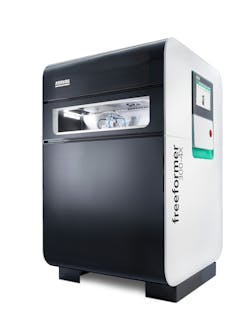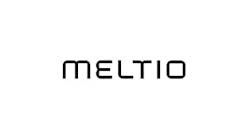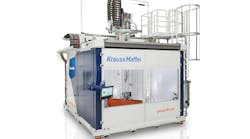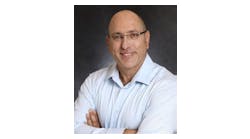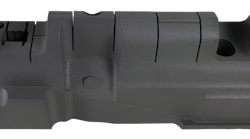At K 2019, Arburg demonstrated its Freeformer 300-4X for the first time; the new 3-D printer can produce continuous-fiber-reinforced parts due to its four-axis part carrier and fiber-feeding unit.
The machine continuously feeds glass or carbon fibers onto the part carrier. The printer then encapsulates the fibers with resin to produce parts with tensile strengths up to 500 percent greater than non-fiber-reinforced parts, the company said.
Anything that is currently injection molded with fiber reinforcement, such as automotive parts, could be a candidate for 3-D printing, said Martin Neff, head of Arburg Plastic Freeforming.
The Freeformer 300-4X follows last year’s launch of the Freeformer 300-3X, a model that has a three-axis part carrier. Both models have three discharge units.
The Freeformer 300-4X not only moves in the X-, Y- and Z-axis directions, it also can rotate thanks to the additional axis. The new machine can set down continuous fibers from a roll onto the part carrier in any desired orientation.
“The Freeformer 300-4X is a prototype,” Neff said. “At the K 2019, we have offered a technological insight into how it will be possible to produce fiber-reinforced components in an additive manufacturing process in the future using Arburg Plastic Freeforming.”
Freeformer models can be used in clean rooms and are suited to making medical products, the company said. Multiple Freeformers can also be automated and connected into complete production lines via optional interfaces.
All Freeformers are designed to use standard resin pellets. Users have the option to use their own materials or optimize droplet size.
Bruce Geiselman, senior staff reporter
[email protected]
Contact:
Arburg Inc., Rocky Hill, Conn., 860-667-6500, www.arburg.com
